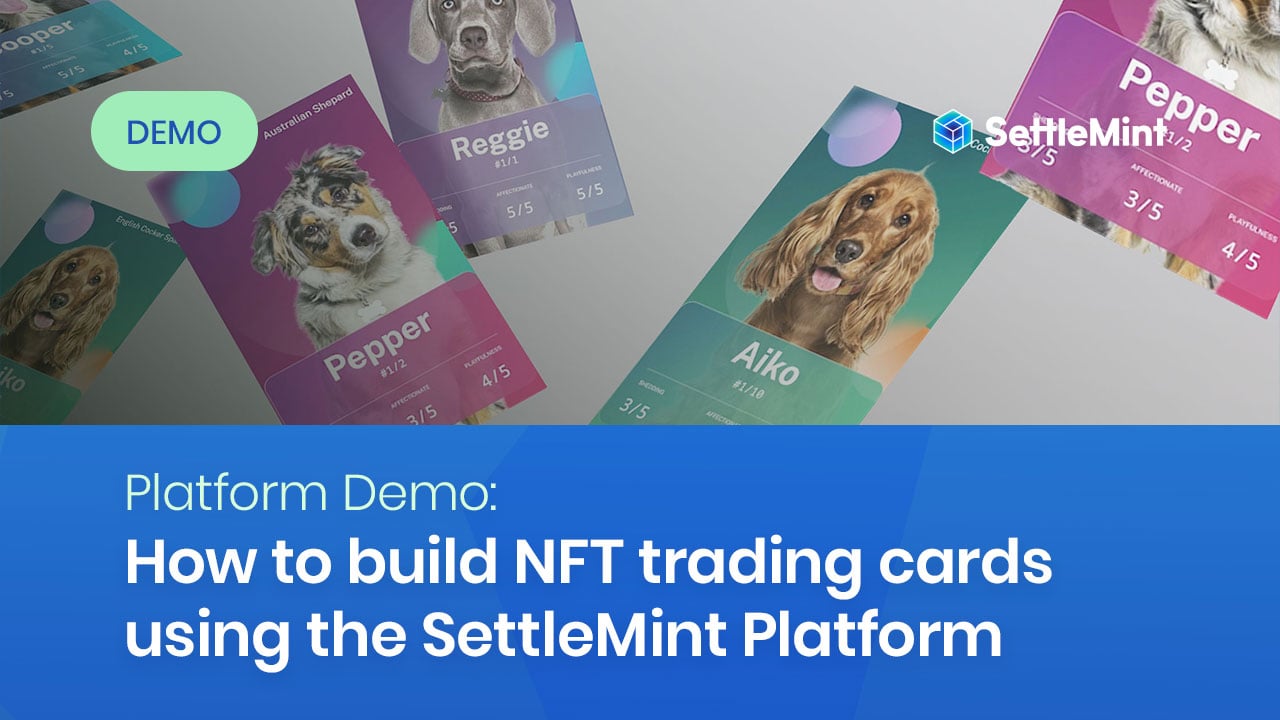Create your own NFT Trading Cards
Follow our step-by-step guide to create your own NFT Trading cards using the SettleMint platform and list them on the OpenSea NFT marketplace.

With SettleMint's blockchain transformation platform, you can easily build and deploy your smart contracts and mint your NFTs. In this video, we cover the basic steps to create your "Metadogs" NFT trading cards:
Selecting the network for your application:
For this example, we shall start by joining a public blockchain network. SettleMint currently supports both private and permissioned networks, as well as the public Ethereum, Avalanche, Binance Smart Chain and Polygon Mainnets and Testnets.
For our “Metadogs” trading cards, we’re using the Polygon Mainnet and Polygon Mumbai Testnet. Both Polygon and Ethereum are supported by the big NFT marketplace, OpenSea, but we’re choosing Polygon because it is fast and has relatively low gas fees.
Choosing your infrastructure:
To set up your blockchain network and nodes, you need to choose the type of infrastructure you want to use for your Mainnet and Testnet, whether Shared, Dedicated, On-Premise or Bring Your Own Cloud (BYOC). For a shared infrastructure, you select the cloud provider and region of your choice. SettleMint supports Amazon Web Services (AWS), Google Cloud and Azure, with several different regions supported per provider.
You also choose the resource pack (memory, vCPU and disk space) that will be allocated to your service, from small to large, depending on the volume of transactions you expect to be doing.
Setting up storage with IPFS:
Your NFT assets are going to be stored on the InterPlanetary File System (IPFS), so you need to set up an IPFS node. You can choose the type of infrastructure, cloud provider and region, and a suitable resource pack.
Creating and funding private keys:
A private key keeps your funds and smart contracts secure. The easiest way to interact with your nodes is by creating private keys in the SettleMint platform itself. You can choose between HSM keys that will not disclose the private key to anyone or Accessible keys that give the mnemonic as well as the private key. You can also use your own keys that you’ve created outside of SettleMint e.g. with MetaMask or other wallet solutions.
Keys you create in SettleMint's blockchain transformation platform will need to be funded. If you want to deploy on the Polygon Mumbai testnet, you can request free Matic using a faucet. If you wish to deploy it on the mainnet, you will need to fund it using your own funds and transfer real Matic to your wallet
Checking the status and metrics of your blockchain networks
SettleMint's blockchain transformation platform provides user-friendly access to a wide range of metrics about the services you’re running. For nodes, you have all the information to connect to your node, with an easy-to-use interface to execute JSON-RPC calls.
You also always have a clear overview of the resources’ usage of all your services, letting you decide whether you need to upscale or downscale depending on your needs.
Building your NFT Smart Contract using one unified IDE
The SettleMint Integrated Developer Environment (IDE) features a library of pre-configured smart contract templates that you can use or adapt as needed, including templates for an ERC-721 token and ERC-721 trading cards. Again, you can choose the type of infrastructure, cloud provider and region, and the relevant resource pack to give you enough memory for your cards.
Using the ERC-721 trading card smart contract template, you can define the various characteristics of your cards, including their scarcity. Each NFT also has a JSON file to store its metadata.
Generating trading cards and minting NFTs:
The IDE contains packaged scripts to test, compile and finally deploy the smart contract to your chosen Testnet or Mainnet. Note that before deploying to production, you should deploy to a Testnet and make sure you can verify the contract there.
Once the smart contract is deployed, the different trading cards will be generated, and all the NFTs on the smart contract will be minted. You’ll be able to see the individual image and metadata files in the File Manager in the Storage section of the SettleMint platform, fully set up to import into a marketplace like OpenSea.
List your NFTs on a marketplace:
To use a marketplace like OpenSea, you need a Metamask, or a different wallet configured with the correct networks. Copy your smart contract address and register it on OpenSea or any other NFT marketplace. Once it’s registered, set your price and place your NFT for sale.


